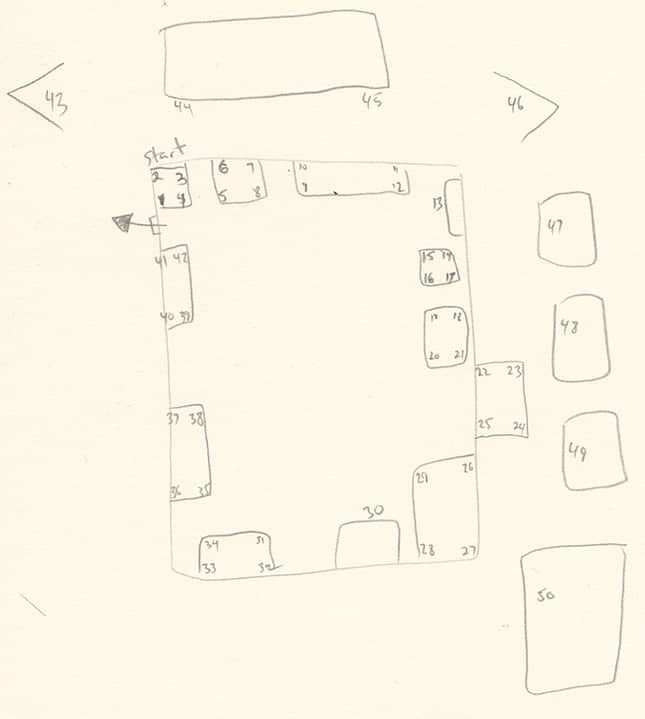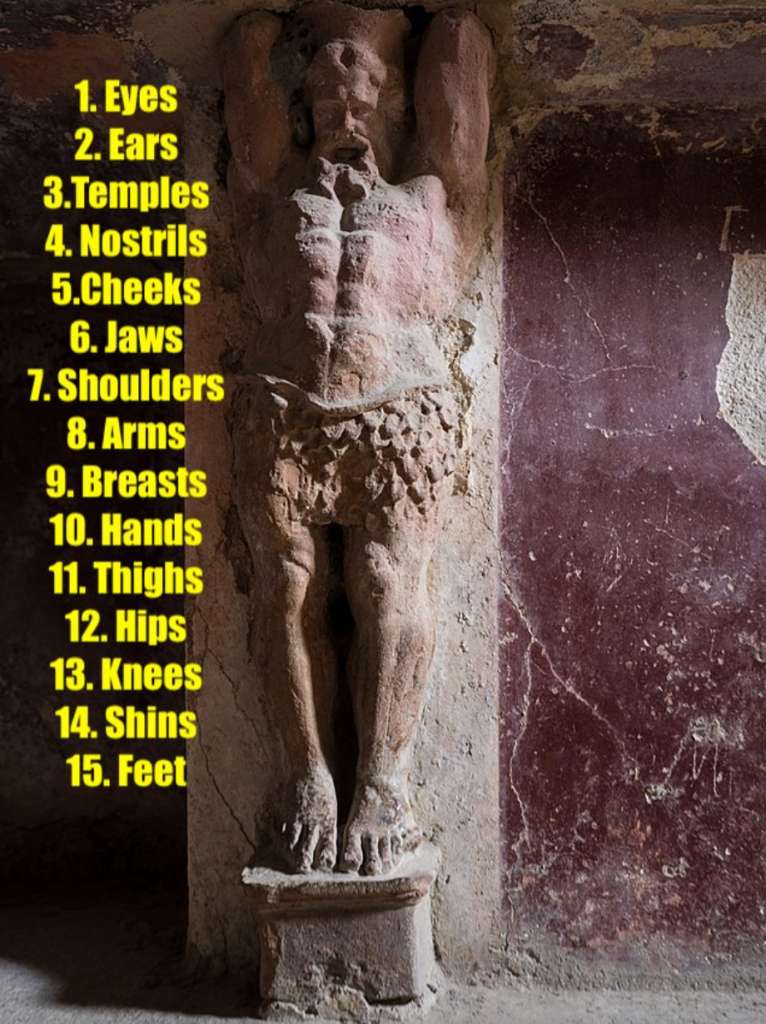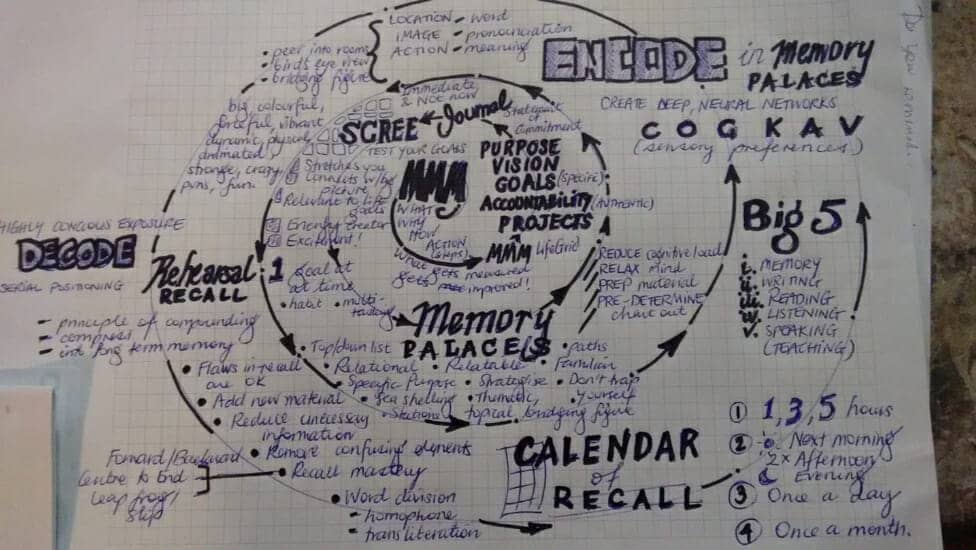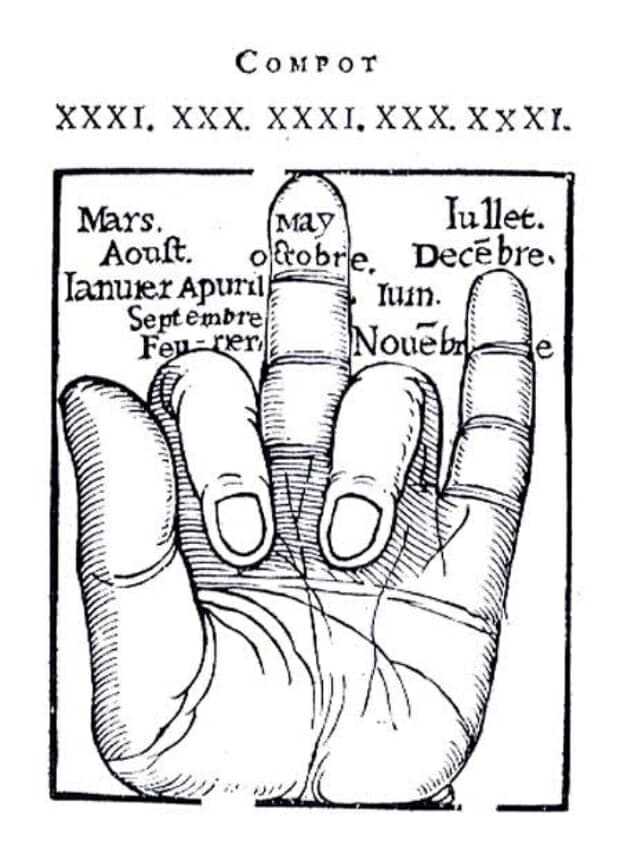 When I started using memory techniques back in grad school, I worried that I was going to quickly run out of Memory Palace ideas.
When I started using memory techniques back in grad school, I worried that I was going to quickly run out of Memory Palace ideas.
I had tons of textbooks to cover, after all!
Even though I’d heard that many memory champions and professional mnemonists have hundreds of these mnemonic tools, I still doubted myself.
I had barely traveled at that point and barely knew about the technique and how it really works.
I needn’t have worried, however.
That’s because today I’m giving you concrete examples from a wide variety of people.
Some are students of my Magnetic Memory Method Masterclass.
Many are from my friends in the memory competition world.
Others come from the ancient history of this technique.
I’ll even share with you a few of my own.
Most of them are deeply influenced by examples from all of the sources above.
Ready to dive in and discover where to find Memory Palaces?
Let the search begin!
L.O.C.I: A Mental Tool For Testing
The Worth Of These Memory Palace Ideas
Before I dive into a list of examples, it’s useful to have a means of deciding whether or not one of today’s ideas will work for you.
Since the Memory Palace technique is based on the method of loci, I came up with a handy acronym for you:
- Location
- Does the memory space you choose support linear or logical navigation?
- Ownership
- Is the location lodged deeply enough in your memory that you feel like you “own” it? This guideline doesn’t mean that you remember every single detail. Just that it resonates with you in a personal way.
- Clarity
- Will you be able to clearly and distinctly navigate the space? Cluttered spaces with no clear journey can create obstacles that drain you of mental energy.
- Indexable
- Can you name the place or give it a number? Although not always necessary, it’s often important for mnemonic linking to be able to refer to the Memory Palace some kind of word-based or number-based label.
Keep this “L.O.C.I.” acronym in mind as you sort through the Memory Palaces ideas that follow.
Memory Palaces Based On Buildings
The Memory Palace technique usually involves buildings you’ve visited. These can include:
- Your home
- The homes of relatives, friends, babysitters, real estate you’ve considered
- Churches
- Museums
- Art galleries
- Government buildings
- Schools and university campuses
- Swimming pools
- Pool halls
- Bookshops
- Grocery stores
- Arenas
- Concert stages
- Airports
- Libraries
- Clubs
- Cafes
- Workplaces (offices, warehouses, factories)
What additional Memory Palace examples come to your mind?

Memory Palaces Based on Outdoor Locations
My personal preference used to be buildings and the only time I would stray was when I used vehicles to memorize playing cards.
These days, I’ve expanded my collection of Memory Palaces and use:
- Streets
- Parks
- Skateboard parks
- Parking lots
- Rivers
- Mountain ranges
- Amusement parks
- Zoos
- Farms
- Bus routes
Some outdoor locations are too difficult because they don’t have enough landmarks.
So when I mention rivers, please understand that I’m using the Brisbane CityCat ferry stops. They’re still all outdoors locations, but their plan lends a specific structure to the mnemonic journey.
How to Find Memory Palaces Ideas from the Indoor & Outdoor Categories
I’ve heard from a lot of people over the years who can’t travel or go outside.
That was once me too.
Long before I was able to travel the world, I spent most of my life indoors during the long Canadian winters.
For me, the initial key to getting together a number of Memory Palaces was to break my schools down to individual classrooms.
For example, in the Memory Palace drawing above, I indexed each room of the high school with the name of the teacher.
In other words, Mr. Ralston’s class was the R Memory Palace. Mr. Schmidt’s class was the S Memory Palace, and so on.
Although small, it was possible to use this one high school in a variety of ways.
Frankly, I believe schools are one of the best places to use as a Memory Palace because most of us spend hundreds, if not thousands of hours in them.
They also provide tactical benefits, including:
- Logical flow
- Distinct landmarks (like baseball diamonds and parking lots)
- Rooms that can be mentally revisited with ease
- Helpful features to use like desks and chalkboards
- Usually aren’t cluttered or abstract
Body Memory Palaces
Although limited in size, it’s possible to use any human or animal body as a Memory Palace.
Ron White and I discussed his approach in depth in this episode of the Magnetic Memory Method podcast.
As with all Memory Palaces, it’s important to keep the rules of L.O.C.I. I mentioned above in mind.
This approach is very difficult to tap out provided you develop a proper pegword system.
In brief, the pegword system I use gives me at least one person for each letter of the alphabet (Adam West for A, Brad Pitt for B, etc.)
Each figure has 10 Magnetic Stations.
This means that if you have one figure for each letter of the alphabet, you’ll have 260 stations per pegword list you develop.
You can prepare lists based on the kinds of categories used by many of our ancestors through ars combinatoria (the art of combination).
In other words, I just mentioned a couple of actors, but you can go far beyond that by having Body Memory Palace Networks based on:
- Actors
- Friends
- Relatives
- Teachers
- Politicians
- Lawyers
- Authors
- Librarians
- Musicians
- Artists
- Philosophers
- Miscellaneous historical figures
- Inventors
- Explorers
- Scientists
- Police
- Doctors
- Dentists
- Manicurists
- YouTubers
- Copywriters
- Your favorite mnemonists (hint hint!)
I’m sure you can think of more categories. The key is to keep developing more over time.
And in case it isn’t obvious, you can double the strength of any Memory Palace by populating them with Body Memory Palaces.
This suggestion was inspired by a strategy outlined by Giordano Bruno in his book, Thirty Statues.
In his work, he suggests 30 Magnetic Stations per body. Personally, I find that too much so use Ron White’s suggestion of 10.
Memory Palaces Based on Shapes & Objects
Let’s say you really like Body Memory Palaces.
You can also break the body down into sections.
When I use my fingers, for example, I think of them like objects.
Likewise my wrist when I memorized the carpal bones.
Essentially, your hand and other parts of your anatomy comprise geometrical shapes. To help you better break things down, give this tutorial on using geometrical shapes for your Memory Palaces a watch:
If you’d like to work with the cards you see in the video, they’re a wonderful product created by my fellow mnemonist John Michael Greer.
Other objects you can use include rings, keys, coins, even the buttons on your own shirt.
The key consideration when selecting objects is again found in the L.O.C.I. set of guidelines.
Although you can use a grain of sand as a Memory Palace… is it really going to help you achieve much?
Always keep the goal in mind as you develop your Memory Palace Networks.
Memory Palaces Based On Imagination
Now, you might be wondering:
Is it possible to create Memory Palaces out of thin air?
Yes and no.
When thinking about virtual Memory Palaces, keep in mind that they are always referential.
Here’s what I mean:
Whether you choose a game that has a fortress in it, or develop one on your own, that imaginary fortress is based on your more practical concept of what similar buildings look like in reality.
Some people do just fine with such Memory Palaces and that’s great.
But for many of us it adds a level of cognitive load because we have to memorize the location or object to which we have no practical connection.
Here’s what matters most:
Experiment.
If you run into issues, no problem. You’ll have learned something.
Don’t run away too soon, however.
What you might struggle with in the beginning can soon become easy after a bit (or a lot) of deliberate practice.
Real-World Examples from Magnetic Memory Method Students
During over a decade-and-a-half of teaching the Memory Palace technique, I’ve received countless examples from lifelong learners around the world.
Here are some of my favorite examples they’ve sent me.
Kevin Richardson
As Kevin told me on the Magnetic Memory Method podcast, he originally learned about Memory Palaces and then dropped them for two years.
Eventually, he came back and used my teaching to help himself finally understand how to use the Memory Palace approach for language learning.
Next thing Kevin knew, he was able to understand tons of Japanese.
Keko
When Keko heard me talk about combining Memory Palaces with mind maps, she determined to give the technique a try.
As you can see above, she used my “sea shelling” principle to create a “path on paper” she could mentally navigate for spaced repetition of my lessons.
Although some minds might find this approach challenging, it’s worth experimenting with at least a few times.
Lee Escobar
I’ll never forget Lee Escobar reaching out for one-on-one coaching for a very specific goal.
As a speaker, he wanted to remember the names of all his attendees… and their seat number.
Having this knowledge committed to memory enabled him to write a highly personalized presentation that blew his audience away.
Don’t take my word for how amazing his results were after I showed him how to accomplish this goal.
Lee himself sent me the results to share with you via this video:
I’ve got dozens of success stories like this on my testimonial page.
But let’s turn now to some examples from memory champions and memory experts I’ve known over the years.
Example Memory Palaces from the Pros
As far as I can tell, the only difference between people who become highly skilled with Memory Palaces and those who don’t is a willingness to study and practice this special mnemonic device.
Here are some of my favorite success stories.
Jonathan Levi
When Jonathan Levi visited me in Berlin, the first thing he wanted was a personal lesson in creating the perfect Memory Palace for his upcoming TEDx Talk.
The image you see above is the result. It’s very similar to the kind of Memory Palace I used to memorize my own TEDx Talk several years later.
As a successful entrepreneur, Levi nailed that talk and even shared it in the presentation. Although he’s now a retired mnemonist, he taught memory techniques to thousands of people during his run.
We tested each other more than once during our many hang outs and he really knows his stuff.
Alex Mullen
Alex Mullen won the World Memory Championship three times.
As he has discussed and shared, he uses his own home as a main Memory Palace.
Want to know what it looks like inside?
Give this video a view:
Don Michael Vickers
Although I don’t have a picture of any of his Memory Palaces, I’ll never forget Don Michael Vickers telling us about how he uses locations like Tim Hortons during this episode of the Magnetic Memory Method Podcast.
He’s so fast with his Memory Palaces, he memorized 50 words in just under 38 seconds?
You can watch him do it under official conditions on MemorysportsTV.
There are other examples from other pros, but these are my favorite that come to mind.
Personal Practice: My Top 4 Favorite Memory Palaces
I’ve been using Memory Palaces for decades now. 2003 feels like a lifetime ago, but that’s when I first got into them.
I first learned about the technique via my interest in card magic and memdeck applications. Then I deepened my understanding by reading extensively about the ancient memory tradition.
Most of my Memory Palaces are simple, but some are a bit more complex. Here are my three favorites.
Mandarin Chinese Class Memory Palace
I still don’t know what I was thinking.
Jonathan Levi and I were developing a non-memory business together and the Magnetic Memory Method project was hopping.
But I’d so enjoyed visiting China and learning about the mnemonist Matteo Ricci‘s adventures there, I just knew I had to learn more about the language.
And so I did.
Without too much time on my hands, I used the Chinese classroom itself for much of the task. You see my sketch of it above.
I also combined a few mind maps with Memory Palaces, like this:
Finally, I used my optimized flashcard method quite a bit.
Although technically flashcards aren’t Memory Palaces, my colleague and Zettelkasten expert Sascha Fast recently told me he thinks they’re close enough. I agree.

Zamalek in Cairo
When I visited Olly Richards in Cairo, I had big plans to learn as much Egyptian Arabic as possible while there.
A few days in, however, I fell off a camel. I got hurt so bad, I wound up not doing much language learning at all.
I did visit a bookstore in Zamalek, however.
It impressed me so much that I immediately sketched it out. I still use it to this day.
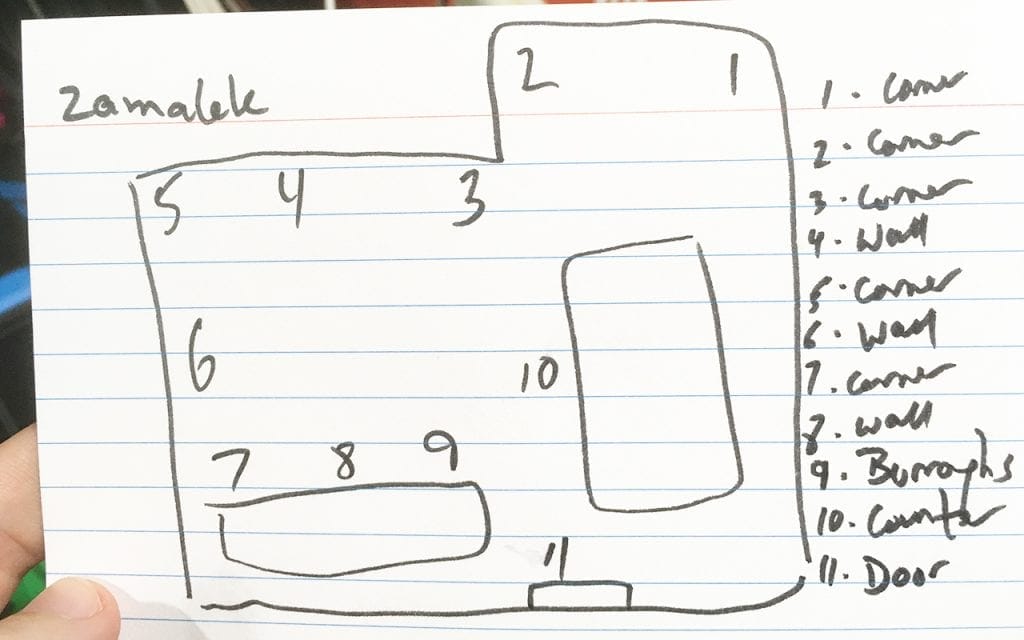
My TEDx/Sanskrit Memory Palace
People ask me often about reusing Memory Palaces.
Although you certainly can do it, I normally prefer to avoid this practice. There are lots of issues that can arise, as discussed in this video tutorial about what mnemonists often call “ghosting”:
Call me crazy, but when I was asked to give a TEDx, I thought I’d risk it.
I’ve used this same Memory Palace three separate times. Not only that, I used it in three separate ways.

In addition to the TEDx Talk, there are two long-form mantras in it based around dozens of Sanskrit phrases.
I go into detail about how I managed to pull all of this off without making mistakes in the Magnetic Memory Method Masterclass.
But to be frank with you: I won’t take that risk again.
It was worth it for the experiment, to be sure. But I ultimately feel that my performance of the talk would have been better in a completely unused Memory Palace.
The “Sand Talk” Memory Palace
In Sand Talk, Tyson Yunkaporta teaches a very simple Hand Memory Palace.
Basically, you link the rules for a meeting to your four fingers. As you touch your thumb and each finger together, you recite: “Connect, Respect, Reflect, Direct.”
I showed Tyson that I had used it during our interview and I’ve been using it ever since. There are many other ways to use hands as Memory Palaces, and I look forward to spending the rest of my life exploring them.
Memory Palace Q&A
Now that we’ve gone through multiple ideas and plenty of examples, let’s get some of the most frequently asked questions answered.
Question 1: What is the best location to start with when new to the Memory Palace technique?
I believe it’s best to give your mind the easiest possible option.
That could be your home, workplace or school.
The key is that the location is already in your memory.
I don’t advise people to memorize locations because that would be the “Memorized Palace technique.”
A true Memory Palace is based on a location already in your memory.
Question 2: How do experts choose their Memory Palaces?
The answers vary.
Memory athletes need speed so their Memory Palaces tend to be clear.
For my personal projects, I often need a lot of volume. So I look for places with big rooms and large walls.
Originally, I struggled with hanging associations in the air. But now I’m much better at it and much of my TEDx Talk is outside.
Ultimately, I find that the more people practice, the more quickly they develop a personal “mnemonic style.” They develop an intuition for what kinds of Memory Palaces work best for their goals.
Question 3: How many loci should a Memory Palace have?
If you’re just starting out, I suggest getting familiar with 8-10.
That will prepare you for many more.
In the image above, you can see the Memory Palace I used for hiragana. It has 48 loci, which I could easily use because I’d already had years of experience.
That said, some people take to this technique very easily.
So it’s important that you experiment.
Try to avoid the idea that there are any “magic numbers.”
Set goals instead and develop Memory Palaces that will help you achieve them. You can always split large goals across multiple Memory Palaces.
Question 4: What factors make a location bad for use as a Memory Palace?
First things first, having negative emotions associated with a location can make it a bad idea to use certain locations.
There are some exceptions to this rule, but generally I suggest picking either happy or emotionally neutral places.
Beyond that, if the locations are overly complex like shopping malls, this can be bad.
Not all hope is lost, however. You can always break shopping malls down into individual stores and corridors. I’ve done that quite a bit.
Some people say that the locations should not be bland or visually unexciting. I haven’t found that to be an issue personally, however.
Many university campuses feature buildings that aren’t particular exciting. They’re just long hallways with doors leading into classrooms.
But I’ve found them perfectly suitable, so long as I hold them in memory. In some cases, bland locations are the best because they don’t distract from the task at hand: using them to memorize information.
Question 5: How many Memory Palaces should I have?
I believe you should develop as many as you possibly can across your lifetime.
Even if you only do it for the brain training, constantly exercising your spatial memory is a very good thing.
If you’re a lifelong learner, even better. You’ll easily remember what you study using the abundance of Memory Palaces you have on hand.
Final Thoughts on Finding Powerful Memory Palace Ideas
When I was just starting out, I had the benefit of years practicing both sleight-of-hand magic and music.
So I knew that it was going to be a lifelong learning journey that involved continually refining my technique and gathering more locations.
Now you have a proven framework that took me years to develop: L.O.C.I.
Always keep in mind that the best locations aren’t necessarily exotic. So long as they’re familiar and lend themselves to mental navigation, you’ll have no problem using them.
Treat your attention as the gateway to finding and using more Memory Palaces. They are literally every way. You just have to notice them and develop them.
Need more help? Sign up for my free memory improvement course:
It gives you four free video tutorials and three worksheets that walk you through everything you need to know.
So what do you say?
Are you ready to develop some Memory Palaces and use them to experience deeper recall, sharper thinking and long-term retention?
Make it happen!
Related Posts
- Tap The Mind Of A 10-Year Old Memory Palace Master
Alicia Crosby talks to us about how she memorized all of Shakespeare's plays in historical…
- MMMPodcast Episode 001: 5 Ways To Ruin A Perfectly Good Memory Palace
In this session of the Magnetic Memory Method Podcast, I talk about the 5 ways…
- How to Use Superheroes In A Memory Palace To Learn Faster
If you know Batman, you can use him to help you memorize foreign language vocabulary…

